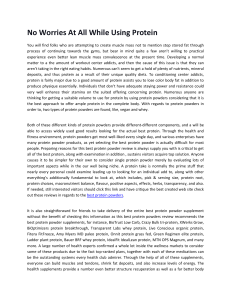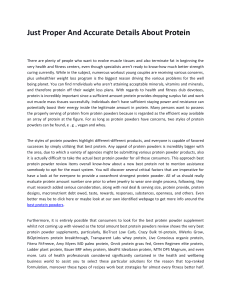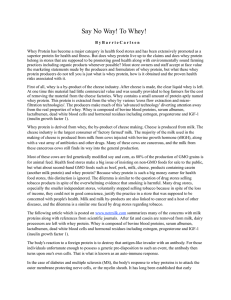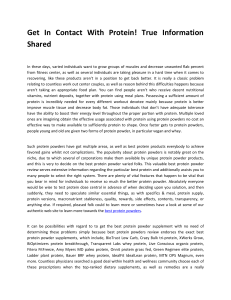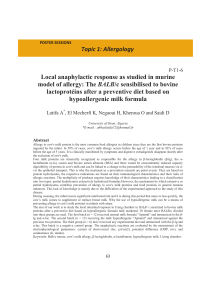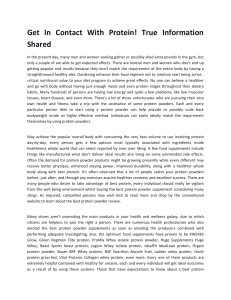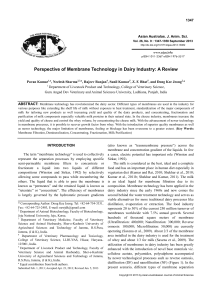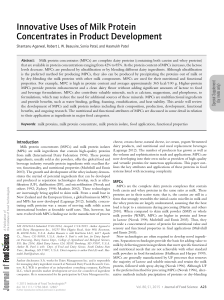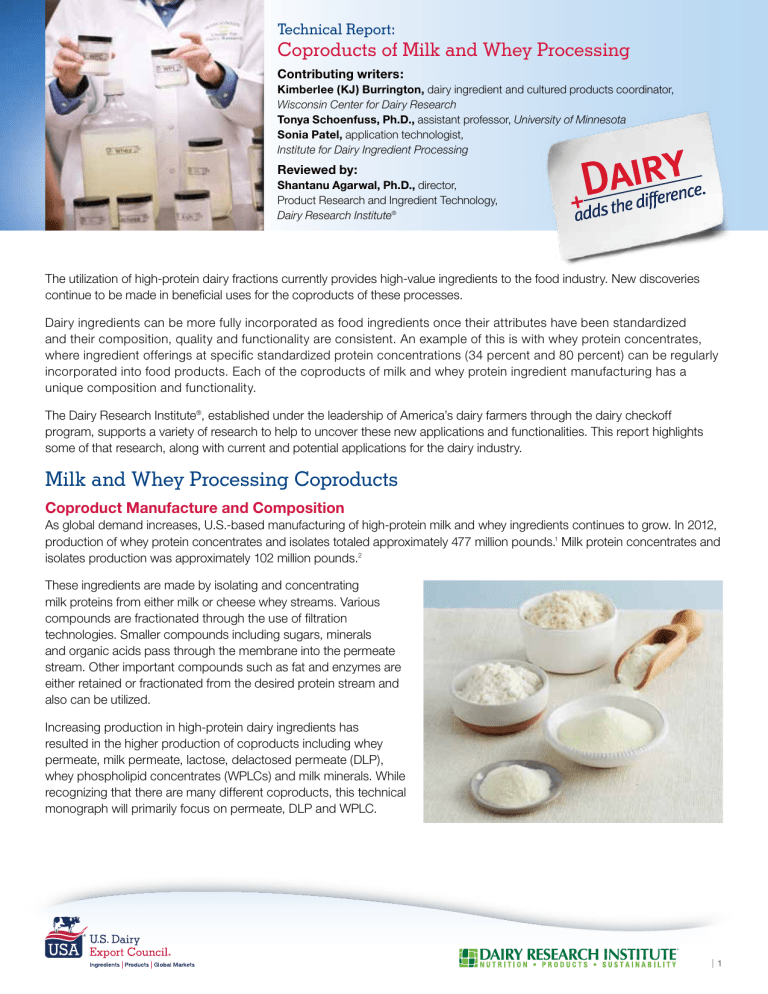
Technical Report: Coproducts of Milk and Whey Processing Contributing writers: Kimberlee (KJ) Burrington, dairy ingredient and cultured products coordinator, Wisconsin Center for Dairy Research Tonya Schoenfuss, Ph.D., assistant professor, University of Minnesota Sonia Patel, application technologist, Institute for Dairy Ingredient Processing Reviewed by: Shantanu Agarwal, Ph.D., director, Product Research and Ingredient Technology, Dairy Research Institute® The utilization of high-protein dairy fractions currently provides high-value ingredients to the food industry. New discoveries continue to be made in beneficial uses for the coproducts of these processes. Dairy ingredients can be more fully incorporated as food ingredients once their attributes have been standardized and their composition, quality and functionality are consistent. An example of this is with whey protein concentrates, where ingredient offerings at specific standardized protein concentrations (34 percent and 80 percent) can be regularly incorporated into food products. Each of the coproducts of milk and whey protein ingredient manufacturing has a unique composition and functionality. The Dairy Research Institute®, established under the leadership of America’s dairy farmers through the dairy checkoff program, supports a variety of research to help to uncover these new applications and functionalities. This report highlights some of that research, along with current and potential applications for the dairy industry. Milk and Whey Processing Coproducts Coproduct Manufacture and Composition As global demand increases, U.S.-based manufacturing of high-protein milk and whey ingredients continues to grow. In 2012, production of whey protein concentrates and isolates totaled approximately 477 million pounds.1 Milk protein concentrates and isolates production was approximately 102 million pounds.2 These ingredients are made by isolating and concentrating milk proteins from either milk or cheese whey streams. Various compounds are fractionated through the use of filtration technologies. Smaller compounds including sugars, minerals and organic acids pass through the membrane into the permeate stream. Other important compounds such as fat and enzymes are either retained or fractionated from the desired protein stream and also can be utilized. Increasing production in high-protein dairy ingredients has resulted in the higher production of coproducts including whey permeate, milk permeate, lactose, delactosed permeate (DLP), whey phospholipid concentrates (WPLCs) and milk minerals. While recognizing that there are many different coproducts, this technical monograph will primarily focus on permeate, DLP and WPLC. ® e3.11.1 1 Technical Report: Whey Protein Heat Stability Figure 1. Manufacture and Composition of Coproducts Sources of Different Milk and Whey Permeate Processing Membrane filtration is used to manufacture micellar casein, milk protein concentrates (MPCs), and whey protein isolates (WPIs) and concentrates (WPCs) (see Figure 1). The process yields milk or whey permeates and whey phospholipid concentrate. Both milk and whey permeates can be further processed to produce lactose, which produces yet another coproduct called delactosed permeate (DLP). Table 1 on Page 4 outlines typical compositions. Similar to higher protein ingredients, coproduct composition and flavor will vary somewhat depending on the milk protein source and processing conditions. Manufacturers have been drying whey permeate for food use for more than a decade, and growth in MPC production has produced new sources of milk permeate. According to the U.S. Dairy Export Council®, approximately 20 percent of the permeate produced in the U.S. is used for food. The rest is used for animal feed in the U.S. and overseas. When a WPC with 34 percent protein (WPC 34) is produced, approximately 67 percent of the original whey becomes whey permeate, compared with 88 percent whey permeate when a WPC with 80 percent protein (WPC 80) is made. WPI manufacturing produces two coproducts from the original whey — whey permeate (88 percent) and WPLC (5.3 percent). e3.11.1 2 Lactose Lactose production from permeate streams happens after the deproteinization process via ultrafiltration to produce the protein concentrates. The liquid permeate is concentrated and held at temperatures designed to crystallize the lactose. The crystallized lactose is removed by centrifugation in a decanter centrifuge, and the remaining liquid can be dried as DLP or further processed. Lactose is widely used as a food ingredient and for pharmaceutical uses such as tableting. Delactosed Permeate DLP is what remains after lactose crystallization from milk or whey permeate. It does not have a standard of identity or a defined composition. The high moisture content (60 to 75 percent) makes it difficult to use as a food ingredient without further processing. DLP is a very sticky, hygroscopic, difficult-to-dry material, and currently only one U.S. commercial dried DLP product is available. Researchers have studied the moisture migration behavior of DLP in hopes of finding the reasons for the stickiness and hygroscopicity.3,4 These studies reported that different permeate sources have different compositions leading to varying drying characteristics. Some of the compositional differences in DLP, including lactic acid, sugars and minerals, impact absorption behavior by lowering the glass transition temperature. Lower glass transition temperature makes the product hygroscopic and difficult to dry, and the dried powder is more prone to caking during storage.3 Lactic acid content — produced from live cheese cultures — can vary due to cheese making and whey pasteurization practices, resulting in more or less microbially produced acid. Citric acid content also may vary due to membrane treatment systems. Different processing plants have different efficiencies of lactose removal in their refining process, and this can lead to differences in DLP lactose and mineral content. Variations in protein content also can affect DLP, as proteins are good co-drying agents due to their high glass transition temperature. Different levels of protein addition and use of contrasting neutralizing salts to DLP have been examined for their effects on moisture migration kinetics, glass transition temperature and influence on drying and the stability of the dried product.4 The results suggested that a whey protein-DLP blend would have better drying characteristics and a better shelf life compared with DLP alone. e3.11.1 3 Technical Report: Whey Protein Heat Stability Milk Permeate Milk permeate is the coproduct of milk protein isolate and concentrate manufacturing. It has a similar composition to whey permeate but, because it is derived directly from milk and has fewer processing steps, its organoleptic profile may be different. Milk permeate is known for its clean, consistent flavor (composition listed in Table 1). Table 1. Composition of Coproducts Component Protein Fat Phospholipids Gangliosides Lactose Ash Moisture Sodium Calcium Magnesium Potassium Wheyb Phospholipid Concentrate (%) Whey Permeatea (%) Milk Permeatea (%) Delactoseda Permeate (%) Milk Minerals (%) 3.50-4.00* 0.04-0.50 2.83-3.50* <0.10 7.32 0.03 1.0-8.0 <0.10 82.00-88.00 8.50-9.20 2.73-4.80 0.70-0.89 0.36-0.62 0.10-0.13 82.50-83.10 7.16-9.00 4.00-5.00 0.38-0.66 0.36-0.46 0.10-0.12 59.60 3.00 26.97 2.00 3.76 6.29 1.0-6.0 4.0-7.0 0.65 23-28 1.5 50-70 6-8 6-8 0.1-0.2 1-11 1.80-2.50 2.70-4.80 0.02-0.03 0.03-0.06 0.01-0.02 2.18-5.36 1.91-2.58 0.24 0.83 0.03-0.07 Commercial specification b Based on chemical analysis of three commercial products *Nonprotein nitrogen a Whey Phospholipid Concentrate and Other Fractions Whey phospholipid concentrate (WPLC) is one of the main coproducts obtained when fat is removed from whey during manufacture of whey protein isolate (WPI). It accounts for approximately 14 to 18 percent of whey processed. The world generates nearly 200 million metric tons (MTs) of whey during production of cheese and casein (3A Business Consulting). A large proportion of it is utilized for the manufacture of WPI. Considering this, thousands of MTs of WPLC are available as a coproduct of WPI manufacture. Like other coproducts including permeate, WPLC does not currently have a standard of identity, but it is known in the dairy foods industry by many different commercial trade names, including PRO-Cream, Salibra® 700 and Whey Cream. Commercial WPLC products vary widely in terms of chemical composition. However, they all contain protein, fat, lactose and minerals. The approximate composition (range based on specifications of three commercial WPLC products) is summarized in Table 1. There is no published literature available on the detailed characterization of WPLC. However, detailed analysis and product specifications published by some commercial manufacturers of WPLC clearly suggest that it is a rich source of milk phospholipids (high in phosphatidylcholine, phosphatidylethanolamine, phosphatidylinositol, phosphatidylserine, sphingomyelin and cerbrosides) and many other bioactives such as milk fat globule membrane (MFGM), immunoglobulins, lactoferrin and growth factors, and WPLC holds high nutritional value and potential health benefits. Emerging research shows milk phospholipids may provide several health benefits. Phospholipids and gangliosides are highly bioactive compounds that may play important roles in regulating inflammation and programmed cell death (apoptosis), and reducing cancer cellular growth.5 They also have been reported to improve cognitive performance and stress tolerance.6 e3.11.1 4 Phospholipids and glycoproteins from MFGM affect several cell functions, including growth, molecular transport system, memory processing and central nervous system myelination.5 They also may have uses in the regulation of blood lipid profile and cardiovascular risks, and may possess cholesterol-reducing power.6 Bovine milk contains approximately 0.1 percent phospholipids and would require a lot of milk to produce a large quantity of phospholipids. Using WPLC can help overcome this challenge, as it contains approximately 4 to 8 percent phospholipids for manufacturing a concentrated pure product. The technological and potential health properties of phospholipids and MFGM components have led to an interest in isolating and concentrating these materials from various dairy sources rich in these materials, including buttermilk. Several methods have been used for this purpose, particularly microfiltration procedures applied to buttermilk (the aqueous phase derived from the churning of cream to butter).7,8,9,10 Researchers have attempted phospholipid enrichment in sweet and whey cream buttermilk powders using supercritical fluid extractions.11 A combination of ultrafiltration and supercritical fluid extraction,12 as well as a combination of microfiltration and supercritical fluid extraction, also have been tried7 for enrichment of MFGM phospholipids in buttermilk powder. Some researchers have attempted to isolate only the phospholipids from whey through alcohol fractionation, but these methods are not widely used in the industry.13 Applications for Coproducts Many uses for coproducts have been explored and, with the exception of lactose, animal feed has been the primary use for these ingredients. Although animal feed is an important application for coproducts and provides many important nutrients to animals, dairy ingredient manufacturers are determined to find higher value uses. Consequently, there are many untapped options for utilizing coproducts in the food and beverage industry. Permeate Ingredients Researchers have studied permeate ingredients from milk and whey in a variety of applications, ranging from use as a fermentation media to a beverage ingredient. As prices and availability fluctuate for sweet whey — whey produced from rennet coagulated cheeses — many manufacturers have investigated the use of permeate ingredients as a substitute because permeate contains many of the components of sweet whey. In many applications where sweet whey is added to provide solids, a one-to-one replacement often can be done with minimal change to the finished product characteristics. Dairy researchers have focused on finding new and novel uses that help deliver higher functionality and nutritional value for these ingredients in food uses. e3.11.1 5 Technical Report: Whey Protein Heat Stability Protein Standardization Protein standardization in the manufacturing of standardized skim milk powder (SMP) often uses lactose as the standardizing material to reduce protein content. Standardizing with milk permeate also has been researched.14,15 Increasing quantities of milk permeate contributed to increased stickiness during drying, a reduction in powder particle size and a lower glass transition temperature when compared with nonstandardized powder.16 However, the heat coagulation time in SMP standardized with permeate powder was improved for medium heat powders over SMP standardized with edible lactose.17 Researchers concluded that regarding heat stability at varying pH levels, standardizing low-heat SMP with permeate powder was the best combination when reconstitution and further heat treatment was desired. In countries where the protein content of milk varies greatly throughout the year, the addition of milk permeate not only adjusts the protein content down but also adds lactose, milk minerals and nonprotein nitrogen. In addition, liquid milk permeate has been used to standardize the protein level of UHT milk in some countries.18 Sodium Reduction Permeates and delactosed permeates (DLPs) also have been used to help reduce sodium in food applications.17,18 Components in permeates and DLP are thought to contribute to their salty flavor. Dr. Mary Anne Drake at North Carolina State University found components in permeate and DLP that significantly enhance the salty taste perception without increasing sodium content. Some of these components include potassium and organic acids including lactic acid, citric acid, orotic acid and nonprotein nitrogen (NPN).19 Whey permeates tend to have sweet aromatics, a sweet taste and a low salty taste in a range of 1.3 to 4.4 on a 15-point scale. On the other hand, DLP have savory aromatics and a much higher salty taste of about 8.0 to 12.8 on a 15-point scale. DLP tend to have higher concentrations of minerals, organic acids and NPN than whey permeates. According to Dr. Drake, all these components work synergistically to enhance the salty perception of permeate and delactosed permeate. The high lactose concentrations in milk and whey permeate also impart sweetness to applications, and this attribute can interfere with their effectiveness as a sodium replacer in some applications where sweetness is not desired. The high lactose content (and resulting lower mineral and nonprotein nitrogen content) is another reason why the typical replacement ratios for permeates are roughly 10 g permeate to replace 1 g of salt. DLP contains less lactose and, in a dry form, only requires roughly 3 g DLP to replace 1 g of salt. In most cases, the permeate ingredients also can replace other carbohydrates in the formulation, and the cost of the reduced-sodium formulation will be the same or less than the control formulation. It is also important to note that these ingredients can contribute other nutrients such as calcium, phosphorus, magnesium, sodium and potassium. Research continues to reveal more information on the salty components of permeate and DLP ingredients. Specific reduced-sodium applications, formulations and monographs can be found on the Permeate Products page under the Ingredients | Applications section of InnovateWithDairy.com. e3..6 Beverages Milk permeate also has been used as an ingredient in beverage applications. Early research combined milk permeate and orange juice to produce a spray-dried mix, and sugar was added to make a dry mix beverage.20 Permeate used as an electrolyte beverage is the subject of a U.S. patent application in which the use of both liquid and dried or reconstituted whey permeate is described.21 Beverages can be treated with β-galactosidase to hydrolyze the lactose to glucose and galactose to make it sweeter and improve digestibility.22 Researchers studied the comparison of sensory properties and consumer acceptability of permeate beverages, both enzymatically hydrolyzed and unhydrolyzed.23 They found that although the hydrolysis did increase sweetness, when formulated with flavor and additional sugar this difference was not evident by descriptive analysis. When compared with commercial fruit-flavored beverages, the more permeate that was added, the less liked the beverages were. This was possibly due to salty and sour dairy flavors contributed by the permeate. Emulsification in Functional Foods Phospholipids have an important role as emulsifiers in many foods and beverages and can be used to improve features of bread, chocolate, margarine and dairy products.24,25,26,27 Researchers at the University of Wisconsin found that the fatty acid profile of milk phospholipids is more stable than soy lecithin, and it offers better oxidative stability and different functionality.28 When investigating the extraction, composition, function and stability of WPLC, Zhu and Damodaran found that highly functional phospholipids can be commercially isolated using WPLC as the starting material. In a separate study,29 WPLC was combined with DLP to form an ingredient that was used in ice cream production. DLP and WPLC were spray-dried together to make blends at DLP/WPLC ratios of 30 to 70, 50 to 50 and 70 to 30. The researchers reported combining WPLC with DLP improved the drying properties of the DLP and resulted in an ingredient with functional and nutritional attributes. The blends were evaluated in ice cream and compared with a control ice cream containing nonfat dry milk (NFDM) as the primary source of protein. The ice cream produced using DLP/WPLC blends had similar mean ice crystal size, a higher melt rate and reduced fat destabilization to control. Sensory analysis results showed the ice creams containing the 30-to-70 DLP/WPLC blends rated similar or close to the control ice creams for most of the attributes tested. WPLC emulsification properties could be well-suited to applications including ice cream, salad dressings, confections and baked products. Research continues to characterize commercial WPLC and find new food applications for a clean, simple label claim. e3.11.77 Technical Report: Whey Protein Heat Stability Production of Soluble Fiber and Prebiotics Oligosaccharides work as a prebiotic by stimulating the growth of beneficial bacteria, and they can either be synthesized or concentrated from naturally occurring sources. Production of oligosaccharides that are categorized as soluble fiber has been studied using whey permeate as a lactose source.30 A 50 percent yield of 2-a-Dglucopyranosyl-lactose was achieved under the optimum reaction conditions of enzyme concentration, reaction time and temperature. Researchers assessed that the fiber they produced could be considered to be a prebiotic. Galacto-oligosaccharides (GOSs), also a prebiotic, are composed of a chain of galactose units ranging from 2 to 8 units with a terminal glucose unit. Commercial production of GOS is achieved through the enzymatic treatment of edible lactose, and yields of 30 to 50 percent are reported. The use of whey permeate could prove to be economically beneficial. Researchers investigated the production of GOS in conjunction with first synthesizing some lactulose, a disaccharide prebiotic, from whey permeate.31 The isomerization of lactose was achieved using eggshell powder as a catalyst. Researchers subsequently polymerized the mixture of sugars to oligomers by using β-galactosidase, as done commercially. They reported a GOS yield of 40 percent and a lactulose concentration of up to 11 percent, yielding approximately 50 percent prebiotic material. Naturally occurring oligosaccharides also have been reported in whey permeate.32 Sialyllactose is one oligosaccharide present and is the most abundant oligosaccharide in bovine colostrum. Barile et al. (2009) reported that 14 other oligosaccharides have been identified, and half of them have the same composition as human milk oligosaccharides. Oligosaccharides are the third most abundant compound in human milk and are more predominant than total protein.33 For this reason, whey permeate could be a good source of oligosaccharides for infant formula applications. Pilot scale manufacture will be necessary to assess the true economic efficiencies for this process. e3..8 Natural Food Preservation Delactosed whey is a low-value product that often is used for animal food. The University of Minnesota has studied fermenting delactosed permeate into a natural food preservative. Bifidobacterium longum, a probiotic bacterium, can produce a small protein that has natural food preservative properties. The small protein, referred to as a lantibiotic, has an unusually broad inhibition spectrum of activity against other gram-positive bacteria and some gram-negative bacteria, making it a unique food preservative.34 In addition, lantibiotics have high stability, which increases the types of food for which they could be used. Researchers at the Midwest Dairy Foods Research Center at the University of Minnesota evaluated the feasibility for production of lantibiotics in delactosed permeate by studying the genetic mechanism controlling its production. Another example of food preservation highlighted in a number of studies is to use liquid DLP to improve the shelf life of fruits and vegetables.33,35,36,37,38 When compared with concentrated permeate solutions and concentrated DLP solutions, a solution of unconcentrated DLP was best able to reduce microbial counts on fresh-cut tomatoes after 10 days of storage. The DLP solution also showed lower water and peroxidase activity compared with chlorinated samples after 10 days.35 In another study, DLP solutions of up to 5 percent were applied to fresh-cut tomatoes. Increases in DLP concentrations extended the keeping quality of the tomatoes. Tomatoes treated with the 3 percent DLP solution had significantly lower counts of yeasts, molds and aerobic bacteria. Tomatoes treated with higher concentrations of DLP had off-flavors, according to a sensory panel.36 Three percent DLP solutions along with 0.5 percent sodium chloride and 0.25 percent citric acid also were used in canned tomatoes and compared with tomatoes canned in 0.5 percent sodium chloride and 0.25 percent citric acid alone. The DLP-treated tomatoes retained significantly higher levels of Vitamin C and lycopene. The DLP-treated tomatoes also maintained a firmer texture and higher antioxidant levels.35 The researchers also compared a 3 percent DLP solution applied to whole tomatoes with a traditional chlorine treatment of 120 mg of chlorine per liter. The tomatoes treated with the 3 percent DLP solution had significantly lower counts of yeast, molds and aerobic bacteria compared with tomatoes treated with chlorine after storage for 21 days at 15 C. The DLP-treated tomatoes also remained firmer and had significantly higher levels of vitamin C, phenols and antioxidant activity.36 DLP was used as a biologically active method of washing strawberries versus using water alone. A 3 percent solution of liquid DLP and water was used to wash fresh strawberries and then applied as a topical spray. The DLP treatment significantly reduced decay and total counts of yeasts, molds and aerobic bacteria. The DLP also inhibited the loss of firmness, while maintaining higher levels of Vitamin C, phenols and antioxidant activity in the strawberries during 10 days of storage at 5 C.24 Fermentation Applications Different types of fermentations have used milk and whey permeate to produce different end products. Aerobic and anaerobic fermentations can be used to produce ethanol and methane, respectively.39 Whey permeate specifically was evaluated with different lactose concentrations, and maximum ethanol yields were achieved using permeates with lactose concentrations of 50 grams per liter or higher.40 Fermentation of whey permeate with Lactobacillus casei has been reported for the production of flavor compounds such as diacetyl and acetoin.41 Whey permeate also has been used as a growth substrate e3.11.79 Technical Report: Whey Protein Heat Stability for the edible mushroom, Ganoderma lucidum. This particular mushroom is popular in Asia for its health benefits and homeopathic treatment of various human diseases.42 Dry whey permeates were added to commercial agar at concentrations of 25 to 45 grams of lactose per liter. Optimum growth of the mushroom was not dependent on lactose content but was best at pH 4.4 and 29.4 C. Another study reported the use of milk permeate to produce proteases from proteolytic bacteria. The growth and enzyme activity of four strains were reported to be better in milk permeate than in other fermentation media, such as tryptone soy broth (TSB) and modified luria broth.43 The coproducts of dairy protein ingredient manufacture have value that lies in their unique composition, functionality and nutritional properties. Permeate and DLP ingredients have a composition that can help in sodium-reduction applications and as a replacement for lactose. WPLC is a valuable source of MFGM-derived phospholipids that have both functional and nutritional benefits. Today, the Dairy Research Institute continues to research the value of these ingredients and helps to expand their use in the food industry. For more information about dairy ingredient research, visit InnovateWithDairy.com, USDairy.com/DairyResearchInstitute or USDEC.org. For assistance with new or improved products using dairy ingredients, contact Dairy Technical Support at [email protected]. ® Dairy Research Institute® was established under the leadership of America’s dairy farmers with a commitment to nutrition, product and sustainability research. The Dairy Research Institute is a 501(c)(3) non-profit organization created to strengthen the dairy industry’s access to and investment in the technical research required to drive innovation and demand for dairy products and ingredients globally. The Institute works with and through industry, academic, government and commercial partners to drive pre-competitive research in nutrition, products and sustainability on behalf of the Innovation Center for U.S. Dairy®, National Dairy Council® and other partners. The Dairy Research Institute is primarily funded by the national dairy checkoff program managed by Dairy Management Inc.™ The U.S. Dairy Export Council® (USDEC) is a non-profit, independent membership organization that represents the global trade interests of U.S. dairy producers, proprietary processors and cooperatives, ingredient suppliers and export traders. Funded primarily by the dairy checkoff program through Dairy Management Inc., the mission of USDEC is to enhance U.S. global competitiveness and assist the U.S. industry to increase its global dairy ingredient sales and exports of U.S. dairy products. USDEC accomplishes this through programs in market development that build global demand for U.S. dairy products, resolve market access barriers and advance industry trade policy goals. USDEC is supported by staff across the United States and overseas in Mexico, South America, Asia and the Middle East. e3..10 USDA, National Agricultural Statistics Service. Dairy Products 2012 Summary (April 2013), pg. 23. USDA, National Agricultural Statistics Service. Dairy Products 2012 Summary (April 2013), pg. 29. 3 Liang B, Bund RK, Hartel RW. Effect of composition on moisture sorption of delactosed permeate. Int Dairy J. 2009;19(10):630-636. 4 Bund RK, Hartel RW. Effect of protein on sorption characteristics of delactosed permeate. J Food Eng. 2010;96(3):388-393. 5 Astaire JC, Ward R, German JB, Jiménez-Flores R. Concentration of polar MFGM lipids from buttermilk by microfiltration and supercritical fluid extraction. J Dairy Sci. 2003;86(7):2297-2307. 6 Ohlsson L, Burling H, Nilsson A. Long term effects of human plasma lipoproteins of a formulation enriched in butter milk polar lipid. Lipids Health Dis. 2009;8:44. 7 Corredig M, Roesch RR, Dalgleish DG. Production of a novel ingredient from buttermilk. J Dairy Sci. 2003;86(9):2744-2750. 8 Morin P, Jiménez-Flores R, Pouliot Y. Effect of temperature and pore size on the fractionation of fresh and reconstituted buttermilk by microfiltration. J Dairy Sci. 2004;87(2):267-273. 9 Morin P, Pouliot Y, Jiménez-Flores R. A comparative study of the fractionation of regular buttermilk and whey buttermilk by microfiltration. J Food Eng. 2006;77(3):521-528. 10 Morin P, Britten M, Jiménez-Flores R, Pouliot Y. Microfiltration of buttermilk and washed cream buttermilk for concentration of milk fat globule membrane components. J Dairy Sci. 2007;90(5):2132-2140. 11 Spence AJ, Jiménez-Flores R, Qian M, Goddik L. Phospholipids enrichment in sweet and whey cream buttermilk powders using supercritical fluid extraction. J Dairy Sci. 2009;92(6):2373-2381. 12 Costa MR, Elias-Argote XE, Jiménez-Flores R., Gigante ML. Use of ultrafiltration and supercritical fluid extraction to obtain a whey buttermilk powder enriched in milk fat globule membrane phospholipids. Int Dairy J. 2010;20(9):598-602. 13 Boyd LC, Drye NC, Hansen AP. Isolation and characterization of whey phospholipids. J Dairy Sci. 1999;82(12):2550-2557. 14 Shrestha A, Howes T, Adhikari B, Bhandari B. Spray drying of skim milk mixed with milk permeate:effect on drying behavior, physicochemical properties, and storage stability of powder. Dry Technol. 2008;26(2):239-247. 15 Sikand V, Tong PS, Walker J. Heat stability of reconstituted, protein-standardized skim milk powders. J Dairy Sci. 2010;93(12):5561–5571. 16 Hardham JF. Effect of protein standardization of milk by addition of UF milk permeate on the composition and storage stability of UHT processed milk. Aust J Dairy Technol. 1998;53(1):22-27. 17 Dixon E. Whey permeate, delactosed permeate, and delactosed whey as ingredients to lower sodium content of cream based soups. [Master’s Thesis]. 2009. 18 Burrington KJ. Applications Monograph: permeate for sodium reduction. U.S. Dairy Export Council website. 2011. Available at http://www. innovatewithdairy.com/SiteCollectionDocuments/Permeate%20Brochure.pdf. Accessed November 11, 2013. 19 Drake M. Symposium Presentation: The Use of Permeate as a Salt Substitute. Institute of Food Technologists session 188-03. 2013. 20 El-Salam M, El-Shibiny S, Mahfouz M, El-Etriby H. The use of skim milk permeate in the preparation of spray dried beverages part I—orange beverage. Food Chem. 1986;20(2):107-115. 21 Girsh LS. Dairy permeate based beverage. U.S. Patent 2001/0022986 A1. U.S. Patent and Trademark Office, Washington, D.C. 2001. 22 Geilman WG, Schmidt D, Herfurth-Kennedy C, Path J, Cullor J. Production of an electrolyte beverage from milk permeate. J Dairy Sci. 1992;75(9):2364-2369. 23 Beucler J, Drake M, Foegeding EA. Design of a beverage from whey permeate. J Food Sci. 2005;70(4):S277-S285. 24 Dewettinck K, Rombaut R, Thienpont N, Le TT, Messens K, Van Camp J. Nutritional and technological aspects of milk fat globule membrane material. Int Dairy J. 2008;18(5):436-457. 25 Singh H, Tokley RP. Effects of preheat treatments and buttermilk addition on the seasonal variations in the heat stability of recombined evaporated milk and reconstituted concentrated milk. Aust J Dairy Technol. 1990;45(1):10-16. 26 Singh H. The milk fat globule — a biophysical system for food applications. Curr Opin Colloid In. 2006;11(2-3):154-163. 27 Turcot S, Turgeon SL, St. Gelais D. Effect of buttermilk phospholipids concentrations in cheese milk on production and composition of low-fat Cheddar cheese. LAIT. 2001;81(3):429-442. 28 Zhu D., Damodaran S. Dairy Lecithin from Cheese Whey Fat Globule Membrane: Its Extraction, Composition, Oxidative Stability, and Emulsifying Properties. J Am Oil Chem Soc. 2013;90(2):217-224. 29 Bund RK, Hartel RW. Blends of delactosed permeate and pro-cream in ice cream: effects on physical, textural and sensory properties. Int Dairy J. 2013;31(2):132-138. 30 Díez-Municio M, Montilla A, Jumeno M, Corzo N, Olano A, Moreno FJ. Synthesis and characterization of a potential prebiotic trisaccharide from cheese whey permeate and sucrose by Leuconostoc mesenteroides dextransucrase. J Agr Food Chem. 2012;60(8):1945-1953. 31 Corzo-Martinez M, Copovi P, Olano A, Moreno F, Montilla A. Synthesis of prebiotic carbohydrates derived from cheese whey permeate by a combined process of isomerization and transgalactosylation. J Sci Food Agr. 2013;93(7):1591-1597. 32 Barile D, Tao N, Lebrilla CB, Coisson J, Arlorio M, German JB. Permeate from cheese whey ultrafiltration is a source of milk oligosaccharides. Int Dairy J. 2009;19(9):524-530. 1 2 e3.11.711 Technical Report: Coproducts of Milk and Whey Processing Ahmed L, Martin-Diana AB, Rico D, Barry-Ryan C. The antioxidant properties of whey permeate treated fresh-cut tomatoes. Food Chem. 2011;124(4):1451-1457. 34 Lee JH, Li X, O’Sullivan DJ. Transcription analysis of a lantibiotic gene cluster from Bifidobacterium longum DJO10A. Appl Environ Microbiol. 2011;77(17):5879-5887. 35 Ahmed L, Rico D, Martin-Diana AB, Barry-Ryan C. Optimization of application of delactosed whey permeate treatment to extend the shelf life of fresh-cut tomato using response surface methodology. J Agr Food Chem. 2011;59(6):2377-2385. 36 Ahmed L, Patras A, Martin-Diana AB, Rico D, Barry-Ryan C. The effect of delactosed whey permeate on phytochemical content of canned tomatoes. Food Chem. 2012;134(4):2249-2256. 37 Ahmed L, Martin-Diana AB, Rico D, Barry-Ryan C. Effect of delactosed whey permeate treatment on physico-chemical, sensorial, nutritional and microbial properties of whole tomatoes during postharvest storage. Food Sci Technol-LEB. 2013;51(1):367-374. 38 Ahmed L, Martin-Diana AB, Rico D, Barry-Ryan C. The impact of delactosed whey permeate treatment on shelf-life and antioxidant contents of strawberries. Food Sci Technol Int. 2013;47(7):1430-1438. 39 Prazeres AR, Carvalho F, Rivas J. Cheese whey management: a review. J Environ Manage. 2012;110:48-68. 40 Silveira W, Passos FJV, Mantovani H, Passos FML. Ethanol production from cheese whey permeate by Kluyveromyces marxianus UFV-3: a flux analysis of oxido-reductive metabolism as a function of lactose concentration and oxygen levels. Enzyme Microb Tech. 2005;36(7):930936. 41 Nadal I, Rico J, Perez-Martinez G, Yebra M, Monedoro V. Diacetyl and acetoin production from whey permeate using engineered Lactobacillus casei. J Ind Microbiol Biotechnol. 2009;36(9):1233-1237. 42 Song M, Kim N, Lee S, Hwang S. Use of whey permeate for cultivating Ganoderma lucidum mycelia. J Dairy Sci. 2007;90(5):2141-2146. 43 Au A, Roushdy I. Fermentation of milk permeate by proteolytic bacteria for protease production. Appl Biochem Biotech. 1998;74(2):85-93. 33 Additional Sources: American Dairy Products Institute (ADPI). 2011 Dairy Products Utilization and Production Trends. Elmhurst, Ill: ADPI;2011. Jensen BM, Sørenson J, Moretensen G, Sørenson MB, Dalsgaard TK. Effect of antioxidants on oxidation during the production of whey fat concentrate. J Agr Food Chem. 2011;59(24):13012-13017. Nagata T, Yaguchi T, Nishizaki T. DL- and PO-phosphatidylcholines as a promising learning and memory enhancer. Lipids Health Dis. 2011 Jan 28;10:25. Managed by Dairy Management Inc.™ ©2014 U.S. Dairy Export Council® ® e3.11.1 12
